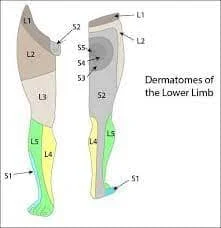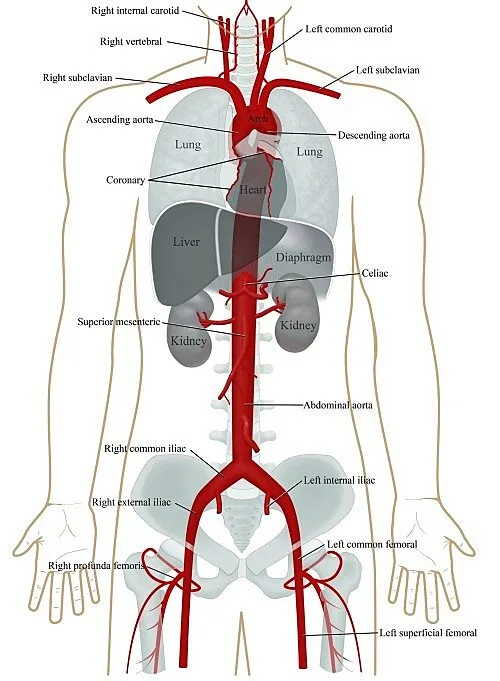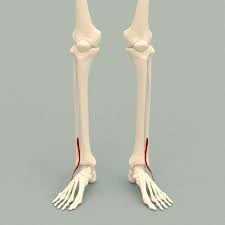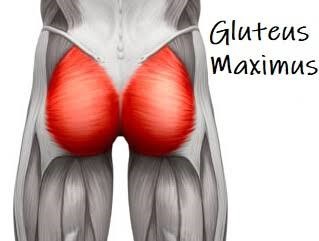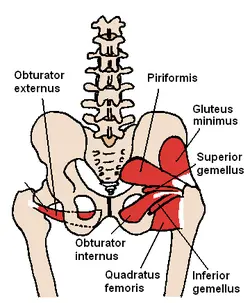Lower Limb Dermatomes
Table of Contents
Definition
Dermatomes are specific areas of skin supplied by sensory nerves from a single spinal nerve root. Lower limb dermatomes refer to the regions of skin on the legs and feet that are innervated by different spinal nerve levels. These dermatomes follow a pattern and help healthcare professionals diagnose nerve-related issues based on the location of sensory symptoms.
Dermatomes of Lower Limb
- L1-L2: Upper pelvis, pubic region, small of the upper back, and genitals (male penises and testicles and male vagina at birth and female vagina and women after birth).
- L2-L3: Includes the muscles of the upper thigh and groin and the small middle of the back.
- L3-L4: Includes the front and outside of the hamstrings (quadriceps), the patella, the outer edge of the leg just above the knee, and the middle of the lower back.
- L4–L5: Patella and front of the lower leg, inner sides of the calf muscles, and the inner surface of the foot, including the big toe and the second and third toes. Dermatomes of the spine of the sacrum and coccyxSacroiliac dermatomes involve areas on the back of the buttocks and legs. There is only one spinal nerve and one associated dermatome in the vertebral column.
- S1 – S2: Upper buttocks (including the gluteal gap, which is the upper area where the buttocks protrude), the middle and outer back of the thigh and the calf muscles, the outside of the ankles, and the fourth and fifth toes.
- S2 – S3: A vertical area in the middle of the buttocks that extends down through the inner-middle part of the back of the thigh and the upper-middle part of the calf muscles. S3 and below: Every spinal nerve from S3 down (including the posterior iliac nerve) connects to the area that includes the genitals, the anus, and the skin area between the two (known as the perineum).
How To Check Dermatomes?
Taking dermatomes means the process of evaluating sensory functions in different areas of the skin. You can use techniques such as the pinprick test (sharp or dull sensation), light touch with cotton, and temperature discrimination (hot vs cold). To accurately identify possible sensory disturbances, it is important to compare the patient’s responses in the tested area and the normal area.
Health Issues Related to Deramtomes
Health problems associated with dermatomes can include a number of conditions. For example, nerve compression or damage can cause pain, numbness, or tingling in certain areas of the skin. The rash can be affected by discs, spinal stenosis, or conditions such as shingles. If you suspect a dermatomal problem, it is very important to consult a doctor for proper evaluation and treatment
How to Take Dermatomes?
Dermatomes testing involves evaluating the sensory function of certain skin areas supplied by nerve roots. This is usually done to diagnose problems with nerves, such as pinched nerves, nerve damage, or nerve compression. By identifying the areas where a person experiences altered sensation, numbness, or pain, medical professionals can better understand the location and extent of nerve disease. Dermatomy testing can help diagnose conditions such as a herniated disc, nerve damage, or certain neurological disorders.
What is the Clinical significance of dermatomes?
Dermatomes have important clinical importance in the diagnosis and localization of neurological problems. They help medical professionals determine the exact location of spinal cord nerve damage or compression. By examining sensory changes or abnormalities in certain areas of the skin, doctors can diagnose conditions such as herniated discs, nerve compression, or spinal cord injuries.
Dermatomy testing helps determine the level and nature of the neurological impairment, guiding appropriate treatment plans and interventions for patients with pain, numbness, or other sensory changes.
What Do Dermatoes Matter To Doctors
Diagnosis: If a patient experiences pain, numbness, tingling, or other sensory changes, knowing the affected dermatome can help healthcare providers identify the potential source of the problem. This helps to make a more accurate diagnosis and prepare an appropriate treatment plan.
Nerve damage: Dermatomes can reveal nerve damage or compression. If it is a specific rash, it may indicate nerve root compression due to a herniated disc, bony plug, or other structural problem in the spine.
Local symptoms: Some diseases, such as shingles, cause symptoms that follow a specific dermatomal distribution. Recognizing this pattern can help with early diagnosis and appropriate treatment.
Neurological Disorders: Dermatomes are valuable in the evaluation of neurological disorders such as radiculopathy due to nerve root compression. Mapping of dermatomes can help monitor the course of the condition and assess the effectiveness of treatment.
Anesthesia and Pain: In anesthesia, an understanding of dermatomes is critical to effectively block the sensation of certain areas during surgical procedures or pain.
Rehabilitation: For rehabilitation purposes, identifying the dermatome distribution can help design targeted exercises to improve muscle strength, coordination, and knowledge in specific areas. Spinal cord injuries: Dermatomes play a role in determining the level and extent of spinal cord injuries. Affected dermatomes can provide insight into the extent of sensory and motor impairment.
Clinical Communication: Dermatomes provide healthcare professionals with a standardized way to communicate and document the location of symptoms or findings. This consistency is critical for accurate medical information and effective patient care.
What are the Dermatomes
Dermatomes are skin areas innervated mainly by certain spinal nerves. They follow a pattern along the body that corresponds to the distribution of nerves. If you’re looking for a visual representation, you can find dermatome maps online or in medical textbooks. Remember to get accurate information from medical professionals or reliable sources.
Many Common Conditions and Disorders That affects the Deramtomes
Shingles (shingles): Shingles are caused by the reactivation of the varicella-zoster virus in the human body, the virus that causes chickenpox in the human body. It usually presents as a painful rash that follows the path of a particular dermatome. The rash consists of clusters of blisters that can be quite painful. The most commonly affected dermatomes are on the chest, abdomen, and face.
Radiculopathy: Radiculopathy occurs when a nerve root is irritated or damaged, usually from compression by a herniated disc or bone cap. This can cause pain, numbness, tingling, and weakness in the specific dermatomal distribution of this nerve. Sciatica is a type of radiculopathy that affects the sciatic nerve, resulting in symptoms radiating down the lower back, buttocks, and legs.
Cervical radiculopathy: Compression or irritation of nerve roots in the cervical spine (neck) can cause pain, tingling, and weakness in the corresponding dermatomes of the hands and arms.
Lumbar radiculopathy: Similar to cervical radiculopathy, lumbar radiculopathy involves compression or irritation of nerve roots in the lower back, causing symptoms in the lower back, buttocks, and legs.
Peripheral neuropathy: Although not exclusively dermatomal, peripheral neuropathy involves damage to the peripheral nerves, which can cause symptoms such as pain, numbness, tingling, and weakness. These symptoms may not follow a specific dermatomal pattern but may affect different parts of the body.
Complex Regional Pain Syndrome (CRPS): CRPS is chronic pain that usually occurs after an injury or trauma. This can cause severe pain, changes in skin color and temperature, and swelling, which may not follow a strict dermatomal pattern but may affect the extremities and other areas.
Diabetic neuropathy: Diabetic neuropathy is a type of peripheral neuropathy that can result from uncontrolled diabetes. This often causes symptoms such as numbness, tingling, and pain in the legs and arms.
Some signs and symptoms related to conditions affecting dermatomes
Numbness and Tingling: Patients may experience numbness or tingling in certain areas of the skin corresponding to the affected dermatome. It can vary from mild to severe sensations and be intermittent or continuous.
Pain: Conditions such as discs or pinched nerves can cause localized or radiating pain along the path of a particular dermatome. Depending on the cause, the pain may be sharp, warm, burning, or aching.
Changes in skin sensitivity: People may report changes in skin sensitivity, such as hypersensitivity, decreased sensitivity, or changes in temperature perception in the affected area. Rash or skin lesions: Conditions such as herpes zoster (shingles) can cause a rash or blisters along the dermatome, often accompanied by pain. The rash follows the specific nerve pathway of the affected dermatome.
Muscle weakness: In some cases, conditions affecting the dermatomes can cause muscle weakness or difficulty performing certain movements, especially if the spinal nerves that control muscle activity are damaged.
Radicular pain: This type of pain radiates along the path of the nerve, often caused by compression or irritation of the nerve. It is felt along the dermatome, extending from the spine to the outer regions of the body. Hyperalgesia or Allodynia: Hyperalgesia refers to an increased sensitivity to pain, while allodynia involves the sensation of pain in response to non-painful stimuli. These sensations may occur on the affected dermatome.
Loss of Reflexes: Nerve compression or damage can result in decreased or absent reflexes associated with the level of the spinal cord affected.
Motor disorders: More severe conditions affecting the spinal nerves can cause muscle weakness or paralysis, especially if the motor nerve fibers are damaged.
Bowel or bladder dysfunction: damage to the nerves that control bowel or bladder function can cause problems such as urinary or fecal incontinence.
How could a person do to prevent conditions and issues that affect the dermatomes?
Maintain good hygiene: Keep your skin clean and dry to prevent bacterial and fungal infections that can affect the rash.
Protect from the sun: Use sunscreen and protective clothing to protect your skin from harmful UV rays, reducing the risk of skin cancer and other sun-related problems.
Healthy diet: Eat a balanced diet rich in vitamins and antioxidants to assess skin health.
Stay hydrated: Drink enough water to keep your skin hydrated and maintain its natural defenses.
Avoid smoking: Smoking can negatively affect skin health by reducing blood flow and causing premature aging. Manage stress: Chronic stress can worsen skin conditions, so practicing stress reduction techniques can be helpful.
Be active: Regular exercise improves circulation, which promotes overall skin health.
Appropriate clothing and footwear: Wear appropriate clothing and footwear to avoid friction, pressure and irritation on certain areas of the skin.
Avoid harsh products: Use gentle skin care products to avoid irritating or damaging your skin.
Regular checkups: See a dermatologist for regular skin exams to catch potential problems early.
Be hygienic in public places: To avoid skin infections, take precautions in public places like gyms, saunas, and swimming pools.
Stay well: Get enough sleep to support your body’s natural healing processes.
FAQ
What are dermatomes?
Dermatomes are specific regions of the skin that are supplied by a single spinal nerve.
How many dermatomes are in the lower limb?
There are eight dermatomes in the lower limb.
Which spinal nerves are associated with lower limb dermatomes?
The lower limb dermatomes are primarily supplied by the lumbar and sacral spinal nerves.
Can you list the lower limb dermatomes and their corresponding spinal nerves?
L1: Upper thigh, supplied by the first lumbar nerve (L1)
L2: Front of the thigh, supplied by the second lumbar nerve (L2)
L3: Front of the thigh and knee, supplied by the third lumbar nerve (L3)
L4: Inner lower leg and foot, supplied by the fourth lumbar nerve (L4)
L5: Outer lower leg and top of the foot, supplied by the fifth lumbar nerve (L5)
S1: Back of the thigh, calf, and outer foot, supplied by the first sacral nerve (S1)
S2: Back of the thigh, buttocks, and back of the leg, supplied by the second sacral nerve (S2)
S3-S5: Buttocks, perineum, and anus, supplied by the third to fifth sacral nerves (S3-S5)How can knowledge of dermatomes be helpful?
Dermatomes can help diagnose the location of nerve-related issues, such as pain or numbness, and guide medical professionals in understanding the source of discomfort.
Are dermatomes the same for everyone?
While there is a general pattern, there can be individual variations in the exact boundaries of dermatomes
Can dermatomes cross from one side of the body to the other?
No, dermatomes are typically symmetric and do not cross the midline of the body.

